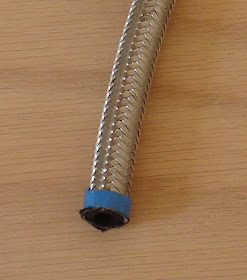Selected stainless steel braided gas lines with 1/4" ID for the motorcycle. The 1/4" ID is a good fit for the gas tank crossover tubes and vent line, but the Mikuni carburettor fuel inlet and Spyke petcock outlet are 5/16. It's possible to force the 1/4" hose over the 5/16 barbs, but the main feed will need to be replaced with 5/16 ID hose for premium performance of the 113 cu.in. Ultima El Bruto motor. The vent line will stay as it is. It is easier to move air through a tube than liquid due to viscous drag. The hose clamps have a chrome housing to dress them up. The chrome housings also cover a greater length of hose than standard hose clamps which improves mechanical support for the hose and reduces wear due to vibration. At least that's the theory. The hose was ordered as a 6ft roll Jireh P/N 71-141 and the clamps have P/N 21-263 (6 clamps per bag).
1/4" Hose with stainless steel braid protection
|
The petcock is a Spyke product which has many different options for the gas spigot.
The stainless steel braid is heavy duty and best cut with a thin abrasive wheel to prevent fraying and crushing. Tape the hose where you want to cut with the cut mark roughly 1/4" from the edge of the tape. Then cut through the braid all the way around the circumference of the hose and finally use a sharp knife to cut through the inner rubber hose. If you cut all the way through the hose with the cut-off wheel, you will generate a lot of rubber dust that will get into the inside of the hose and eventually clog up something somewhere in your carb. A sharp knife cut eliminates most of this problem. It is still a good idea to flush the lines before installation.
Hose marked for cutting
|
Cut gas hose end
|
The tape keeps the braid from fraying after cutting and makes it easier to get the clamps over the ends.
Hose with clamp placed over the cut end
|
The plan was to run the gas line straight up as shown below. This wasn't possible because of interference between the hose clamp and a retaining screw on the carb.
The gas tank requires a crossover as well as a vent. The tank has 2 simple 1/4" tubes directed downward on each side of the tunnel. This means that the crossover is highly visible. Future plan is to cut the tubes out and weld 1/8 NPT bungs into the tank so that the crossover lies flat as possible on the underside of the tank. (UPDATE: this is described here: http://midnightcustoms.blogspot.com/2012/02/part-18-mounting-gas-tank.html )
The vent line connects from the underside of the gas tank into a barb fitting on the rear of the carb (used the most inward fitting shown covered with a black cap in the above picture).
There is little clearance for the vent line with this carb/motor combination. The hose has to make a very sharp bend as it comes out of the carb. This does create a constriction in the hose - just make sure it isn't pinched off - the strength of the braid helps to keep the hose open in the tight bend.
Vent line routing
|
After everything was measured, cut and assembled, the gas tank looked like this:
Hoses installed
|
The gas line ended up a little long which resulted in it touching the underside of the tank. This will abrade the paint due to vibration. The line needs to be shortened to clear the tank.
 |
| Vent line connection |
The bike is slowly but surely taking shape.
 |
| Pro-street mockup |
Rear wheel spacers and alignment coming up next.....





















